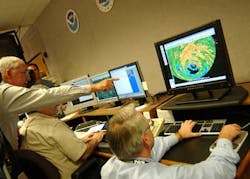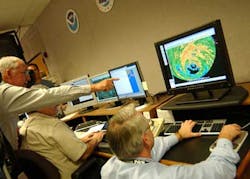Hurricane season is here, know how to reduce risks
Bill Biewenga, Qv21 Technologies LLC, Newport, RI
The warm September morning started out peacefully enough. As dawn approached, seawater was lapping up over the normally-dry parts of the low lying land. Later in the morning, as everyone went on about their normal chores, children played in the slowly rising, almost pond-like water. The local chief meteorologist began to observe the steep drop in the barometer, and he realized that problems were brewing. He began to raise an alarm. Few paid much attention. Within 24 hours, 6,000 people would die, and pictures of the city’s aftermath now look more reminiscent of Hiroshima after its atomic blast in 1945 than of any other city following a storm. That was the scene in Galveston, Texas on Sept. 9 and 10, 1900, after the so-called "Great Storm" swamped the island city, then Texas’ largest.
Hurricanes are not to be taken lightly. It’s true enough that our weather forecasting techniques have improved significantly over the past 113 years, and communications enable us to spread the word far and wide. People are more aware of the importance of taking precautions, especially following more recent events such as Hurricanes Katrina and Sandy. There have been others. There will be more. Already, an above average probability is forecast for major hurricanes along the US coast for the 2013 Atlantic hurricane season, which began June 1 and runs through November.
Putting hurricane realities into perspective, it should be mentioned that the weakest level of hurricane has 74 to 95 mph winds. The strongest is in excess of 157 mph. In 95 mph winds the wind strength prevents people from walking upright. Who would want to? With lawn furniture and barbecue grills flying through the air, an upright person would present a larger target for a multitude of lethal missiles unleashed by the wind. A stunning fact, however, is that in many places, it’s the water that accompanies a hurricane that creates the most devastation. If "knowledge is power," knowing a bit about hurricanes can help us avoid – or at least prepare for – the worst of it.
Staff at the National Hurricane Center tracking a storm. Photo courtesy US National Weather Service.
Weather, not unlike the oil and gas industry, is a complex operation, with a wide range of variables. Tropical low pressure systems, as an example, are quite different from extra-tropical lows – lows that are predominant in areas outside of the tropics. Hurricanes often start out as tropical waves, becoming tropical depressions, lows, and storms if conditions are suitable for development. A variety of criteria must be met in order to progress from tropical storm to hurricane strength.
During the initial stages of a tropical low pressure system, there will be a disturbed area with clusters of thunderstorms. In the Atlantic, as an example, the clusters could be along a tropical wave that originates in northwest Africa or along an old cold front that can occur anywhere from Cape Hatteras, NC to the Bahamas into the Gulf of Mexico. As the tropical wave develops into a tropical depression, the thunderstorms organize, and an area of surface low pressure forms. The thunderstorms converge towards the center of lower pressure. In the Northern Hemisphere, the thunderstorms spiral in a counter-clockwise direction. In the Southern Hemisphere, the thunderstorms spiral in a clockwise direction. When sustained winds are less than 35 mph, the tropical low is classified as a tropical depression.
In order for the tropical depression to continue to develop and become a tropical storm, the inflow of thunderstorms and warm humid air must increase. The pressure continues to fall, and sustained wind speeds must exceed 35 mph. At that point, in the North Atlantic, a tropical storm is named. Although naming protocols vary in other parts of the world, in the N. Atlantic and both the Eastern and Central North Pacific, each storm is named alphabetically beginning with "A" for the first storm of the new calendar year. In the Western North Pacific, the alphabet is not restarted at the beginning of the new year. Rather, the alphabetical process proceeds through "Z" and restarts at "A" without regard to calendar years. Additionally, some parts of the world refer to storms as "tropical cyclones."
With cloud and warm, humid air inflows continuing to build, the center barometric pressure continues to drop. An "eye" is likely to form at the center of the low pressure system. In order to continue storm development into hurricane strength, sea temperatures need to be at least 81 degrees Fahrenheit. Tropical systems become classified as hurricanes when sustained winds reach 74 mph. Warm water provides the energy that fuels the convective system. The warmer the water, the more energy is available for hurricane strength to develop. The moist air and clouds in the vicinity of the system allow for efficient transmission of that energy. And the lack of wind shear allows the convective system to develop fully, reaching higher altitudes and colder temperatures aloft.
Because there are various elements that go into building the strength of a tropical depression, storm, or hurricane, if any of these critical elements are removed, the systems can lose some or all of their strength. As a hurricane goes over land, as an example, it loses its primary source of energy – the warm ocean. Warm air is often replaced by cooler air at the system’s lower altitudes. Additionally, the increased friction over the surface of land slows the inflow of energy into the convective system. Dry air is introduced, instead of the more moist air of the ocean, so fewer clouds are created. And strong wind shear aloft from wind currents such as the jet stream will tear the vertical structure of the storm apart.
Although tropical storms have been recorded in the North Atlantic in every month of the year, and hurricanes have only been absent during the month of April, the primary months for tropical storms are during the late summer. That is when the water is the warmest and wind shear at its minimum.
Where hurricanes tend to form in the North Atlantic and how they tend to track, however, vary somewhat with the month. These are general trends, however, and not at all forecast routes. Each tropical will take on its own characteristics of development and track.
June hurricane tracks in the North Atlantic: Considered early in the North Atlantic hurricane season, June tropical storms and hurricanes frequently form in the Caribbean Sea or Gulf of Mexico. Their tracks generally take them into the Gulf States or across Florida and up the North American East Coast as they re-curve towards Europe.
July hurricane tracks in the North Atlantic: Still somewhat early for the North Atlantic hurricane season, July tropical storms more frequently begin their formation a bit further to the east than the June storms. Tracks often take tropical storms into the Gulf States or northerly along the North American East Coast before they re-curve toward Europe.
August hurricane tracks in the North Atlantic: With the peak of hurricane season approaching and the water temperatures of the tropical North Atlantic continuing to rise, August tropical storms and hurricanes form further to the east. They can form as far east as 40 degrees west latitude or more. With the eastern formation, the hurricanes have more time to re-curve back toward Europe without making landfall in North America.
September hurricane tracks in the North Atlantic: September is the peak month for hurricane formation in the North Atlantic. Water temperatures are among the warmest of the year. There is relatively little wind shear present compared to other times of year, and clouds are plentiful. The hurricanes often begin as tropical waves undulating their way off the northwestern coast of Africa. Formation can take place as far east as 30 degrees west latitude, giving the tropical storms a great deal of distance to develop and/or begin a re-curve toward Europe prior to reaching the Islands of the Caribbean or North American continent.
October hurricane tracks in the North Atlantic: As temperatures begin to drop in October, the water in the tropical North Atlantic cools. Hurricanes and tropical storms tend to again form somewhat further to the west or in the southern parts of the Caribbean. This is not meant to imply that they are less dangerous or potentially less destructive. It is merely meant to say that climatologically, their main areas of formation and frequency are changing.
Hurricane Katrina tore Diamond Offshore’s Ocean Warwick drilling platform (pictured here) loose from its moorings off the Louisiana coast and deposited it 66 miles away on Dauphin Island, Alabama. Photo by Peter Cosgrove, Associated Press
November hurricane tracks in the North Atlantic: Early November is often considered the end of hurricane season. Ocean-going captains departing the North Atlantic bound for the Caribbean often feel that the danger of tropical storms and hurricanes is past. It isn’t. Remember that the only month in recorded history that doesn’t have a hurricane in the North Atlantic is April – and that month has had a tropical storm recorded as recently as 2003. With North Atlantic water temperatures continuing to drop in November, storm formation occurs more often in the Caribbean. Late season hurricanes tend to have somewhat erratic paths. Or, perhaps, another way of looking at it is that, with relatively little data from past late season tropical storms, their paths tend to be somewhat difficult to predict. The hurricane that formed near Jamaica and went "backwards" into the trade winds 15 years ago, going over the British Virgin Islands, St.Maarten, and Antigua from the west towards the east, was a late-season hurricane. Their tracks are difficult to predict and planning should take that into account.
Tracks are not the only aspect to a hurricane that is difficult to predict. Storm surges – the water that is pushed in front of the storm – are also difficult. The storm surge during the hurricane that hit Galveston in 1900 was 15 ½ feet high. The storm surge that hit New England in 1938 was quite a bit higher. They can reach 20 feet or more. And, if the tide is high at the time, the additional height can overwhelm bridges, docks, and other coastal structures, including houses. Following the storm surge, which may only last six hours more or less, depending on the speed and timing of the system, rains will penetrate far inland, causing severe flooding and adding further reaching damage. Like the wind blowing barbecue grills or shutters through the air, the storm surge and subsequent flooding can push vehicles and other larger objects into bridge abutments or other structures. Planning needs to include the removal of all objects that can be carried by the severe winds, and anything portable should be move to high ground. Of course, storm procedures are far more extensive than that, shutting in oil rigs, refineries and terminals is a complex and costly operation. Knowing in advance when it’s required and when it isn’t provides a significant ability to manage both risk and costs.
Weather forecasting became significantly more accurate in the mid- to late-1990s with the increased availability of remotely sensed weather data combined with increasingly accurate weather forecast models. Satellites now circle the globe, providing relatively accurate wind speeds and directions and other observations in near-real-time. The European ASCAT data can be accessed online at http://manati.star.nesdis.noaa.gov/datasets/ASCATData.php/ and the wider swath data from India can be accessed at: http://manati.orbit.nesdis.noaa.gov/datasets/OSCATData.php.
Due to the fact that the data is observed and re-sent via Low Earth Orbiting (LEO) polar satellites, the swaths have periodic gaps in the data that is captured on subsequent orbital passes. Utilizing a number of models and a wide variety of data resources, the National Weather Service’s (NWS) National Hurricane Center provides a good baseline of current hurricane information on its site, www.http://www.nhc.noaa.gov/">nhc.noaa.gov.
Weather forecast models have become increasingly accurate. However, having said that, they are far from perfect. Still the best sources of information are provided by a "man-machine-mix," combining the far-sighted analytical potential of super computers with the critical, subjective perspective of trained and experienced meteorologists. There is a wide range of computer-generated weather models from which to choose, and comparing off-the-shelf models with each other, one can quickly see vast discrepancies. Far better accuracy is generally achieved in the near term when a trained meteorologist "adjusts" the modeling results tempered by experience. The NWS’ Ocean Prediction Center at http://www.opc.ncep.noaa.gov/">www.opc.ncep.noaa.gov provides man-machine analyses and forecasts for the North Atlantic and North Pacific. Alternatively, private weather forecasting services such as Commanders’ Weather at http://www.commandersweather.com/">www.commandersweather.com provide high quality, site specific forecasts anywhere in the world.
Private weather forecasting services provide custom forecasts, identifying issues of importance to individual customers. Whether customers are sailors in remote regions of the Southern Ocean, mountain climbers or balloonists, Formula One racers, shipping companies, airlines, utilities, oil rigs, pipeline terminals, or commodities traders, each industry and customer gains specific information that is critically important to them, their operation, and their location. The increased situational awareness leads to an increased likelihood of speed records, achieving the summit, reduced risk, lowered costs or higher profitability.
The application of many types of comprehensive, timely and accurate data is becoming increasingly prevalent in the oil and gas industry. Weather data is only one example. And hurricane information is a relatively small subset of the overall weather data that can help to improve efficiency. Much like the relative size of hurricanes to the larger weather picture, they are small, but they deserve your attention. The citizens of Galveston realized that less than 113 years ago. The same is true today. Timely, accurate, comprehensive, and actionable information provides a multitude of benefits for the oil and gas industry.
About the author
Bill Biewenga is COO for Qv21 Technologies LLC, a provider of logistics support software. Listed in the Guinness Book of Records, he has written numerous articles about sailing, weather, and how that data is applied to improve competitive efficiencies.



